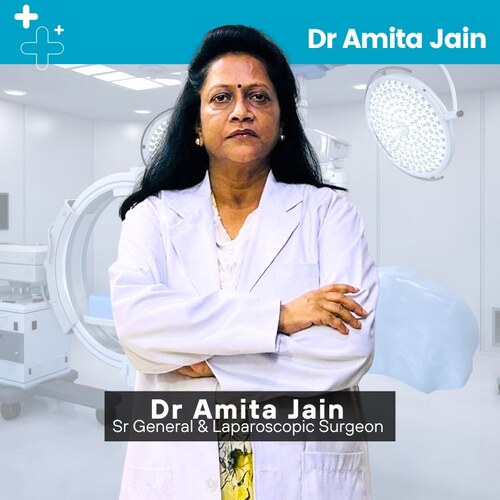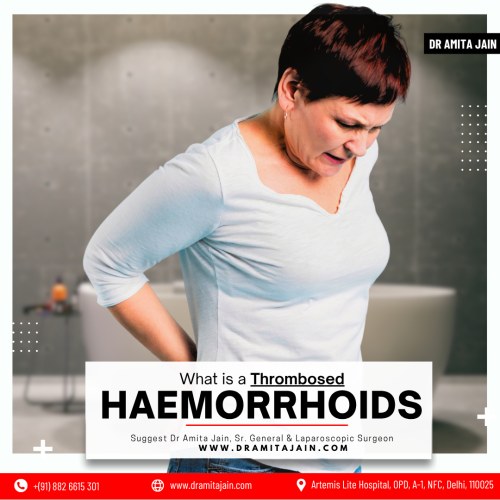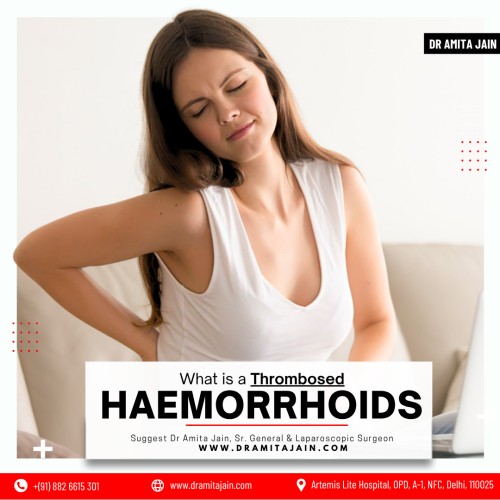Haemorrhoids, or piles, are swollen blood vessels in the end of the alimentary canal area that often cause discomfort, itching, and sometimes bleeding. While many cases are mild, some haemorrhoids can become extremely painful if a blood clot forms inside them. This condition is known as a thrombosed haemorrhoid, and it usually demands more urgent care than regular haemorrhoids. In this article, we’ll explore what thrombosed haemorrhoids are, how to identify them, and the most effective treatments available.
What Are Thrombosed Haemorrhoids?
Dr Amita Jain, a senior general and laparoscopic surgeon and one of the leading surgeons for laser piles surgery and anorectal treatments in Delhi and India, explains that a thrombosed haemorrhoid develops when a clot forms inside a haemorrhoidal vein, typically in an external haemorrhoid located just under the skin around the end of the alimentary canal.
This clot can block blood flow and cause sudden swelling, inflammation, and intense pain. These haemorrhoids often appear as a hard, swollen lump near the end of the alimentary canal opening and may look bluish or purplish due to the trapped blood.
Although thrombosed haemorrhoids are not typically dangerous, they are often described as extremely painful. If left untreated, they can lead to complications such as rupture, infection, or persistent discomfort during bowel movements.
Symptoms to Watch For
The most common symptom of a thrombosed haemorrhoid is sudden, severe pain in the end of the alimentary canal area. This pain often worsens when sitting or passing stool. You may also notice a firm lump near your anus, which can feel tender or sore to the touch. In some cases, the lump may change colour to blue or purple due to the clot beneath the surface.
Other symptoms can include itching, a feeling of fullness or pressure in the rectum, and occasionally bleeding, especially during bowel movements. While bleeding is usually minimal, any persistent or excessive bleeding from piles should be evaluated by a medical professional.
How Are Thrombosed Haemorrhoids Treated?
Treatment depends on the severity of symptoms and how long the haemorrhoid has been present. Mild cases may improve with conservative at-home care, especially if caught early. Warm sitz baths, taken several times a day, can help reduce swelling and promote healing. Applying ice packs and using over-the-counter creams or ointments can also offer temporary relief from pain and itching.
For pain management, oral anti-inflammatory medications such as ibuprofen or paracetamol may be recommended. These help reduce both discomfort and inflammation.
However, in more severe or persistent cases—particularly when the pain is intense or the lump is very large—a minor surgical procedure may be needed. This is known as a thrombectomy, where a doctor removes the clot through a small incision under local anaesthesia. The procedure offers almost immediate relief and is most effective when done within 72 hours of symptom onset.
In cases of large or recurrent thrombosed haemorrhoids, a more extensive surgical approach, such as a haemorrhoidectomy, may be advised to remove the haemorrhoid completely. This is usually done under regional or general anaesthesia and requires a slightly longer recovery period.
Preventing Recurrence
Once the immediate issue is resolved, it’s important to prevent future flare-ups. This includes adopting a high-fibre diet, staying hydrated, and avoiding straining during bowel movements. Regular physical activity and reducing the time spent sitting on the toilet can also lower your risk of haemorrhoids returning.
Thrombosed haemorrhoids may be painful, but they are manageable with the right approach. Whether treated at home or through medical intervention, early attention is crucial for reducing discomfort and preventing complications. If you’re experiencing severe pain around the opening at the end of the alimentary canal or suspect a thrombosed haemorrhoid, don’t hesitate to consult a healthcare professional for an accurate diagnosis and effective treatment plan.

Dr Amita Jain is one of India’s most distinguished and experienced female surgeons, known for her unmatched expertise in general and laparoscopic surgery. With over 29 years of surgical excellence, Dr Amita Jain has built a reputation for precision, compassionate care, and advanced surgical techniques.
Dr Amita Jain has successfully performed a wide range of complex general surgeries, including both open and minimally invasive procedures, with a strong focus on trauma care, onco-surgical techniques, and reconstructive surgeries. Her areas of specialisation include (including Gallbladder stone removal, appendix removal, hernia repair surgery, piles and fissure surgeries). She was the Professor of Surgery at the Army College of Medical Sciences and Base Hospital, Delhi Cantt. In 1994, she was commissioned asa Surgeon under the United Nations Mission in Congo. From 2020 to 2022, she worked with Bansals Hospital. Currently, Dr Amita Jain is the Senior General and Laparoscopic Surgeon at Rainbow Children Hospitals (Malviya Nagar, Delhi), Artemis Lite: Multi-Speciality Care Hospital (New Friends Colony, New Delhi) and at Rosewalk – Luxury Maternity Hospital in Delhi (Panchsheel Park, Delhi)
Call Us at +(91) 882-6615301

